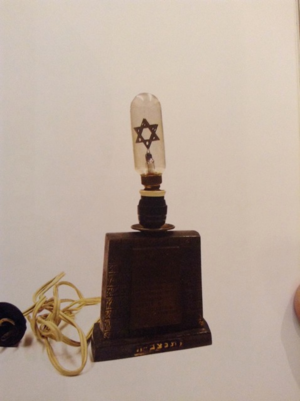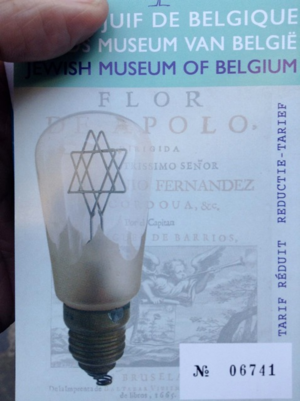I am sad, very sad. For the last few days I have been haunted by the news of the man who pulled up outside the Jewish museum in Brussels, and shot and killed two visitors and a member of staff. There are photographs on the internet of him firing through the door. It is true that there are horrors all round the world every day of the week. If you look at the news websites or simply scan the headlines, abuse and murder are ubiquitous and continuous. But this little local anti-Semitic horror has hurt me in a way I cannot fathom or explain. It is not because I am partial or biased towards the plight of the Jewish people. I am sure equivalent evil has been enacted by every religion against every other religion, at times, and this atrocity does not stand out. It is just that I know and adore this little museum and its staff.
To put my affection for the city into context, I should explain that for many years Brussels - in particular the area around Les Sablons - has been a regular destination for me. I came first in 1990 with my boss, a man called David Nickerson. He taught me all I know. He was overweight, his hair was slightly greasy and swept to one side. He smoked cigarettes as if each puff was going to be his last. His desk at Mallett was legendarily embellished with cigarette burns and every vase in the shop was full of ash and cigarette butts. I once drove his car to deliver a piece to a client and was taken aback by the nicotine crystals pendant from the roof above the steering wheel. In addition to all this he was charismatic, charming and generous to a fault; he was my mentor and guide. He taught me how to look through furniture and objects rather than look at them. He told me to engage with a piece for its line, movement and potential not for its immediate superficial appearance. He embraced life as if each moment would be his last, and that gave both work and fun a vital intense quality that I strive to keep going. On this occasion, we arrived in Brussels and went to the antique fair which was held at the time in the museum, just beside Les Sablons. We walked round and finding nothing to buy, disconsolately repaired to a nearby restaurant. Three hours later and feeling thoroughly restored, we re-entered the fair... and proceeded to buy some of the most exciting things we had seen in a long time. It felt almost magical wafting from booth to booth buying in Belgian francs without really understanding the exchange rate. It all seemed very reasonably priced and in most cases it was.
Since then, the city has been an integral part of my working year, with my annual pilgrimage to TEFAF allowing a stop off on the way, a diversion during, and a break on the way home. Dealers still congregate around the square: as in all cities they have moved away from the expensive rentals and inhabit the lesser, peripheral streets. These provide good spaces and there are still enough dealers with exciting things to act as a draw to the visitor. The shops and the restaurants around them are welcoming and full of curiosity and interest. Since the creation of Masterpiece, I have come to the city even more frequently, to visit our exhibitors, Patrick Mestagh, Galerie Mermoz and Anne Autegarden. Furthermore, the two city fairs each year provide a vital opportunity to both buy and talk to current and potential exhibitors. Particularly BRAFA, each January, has become an important cog in the global fair-going machine.
At some point on each visit, as I trawl along the streets peering in windows or walking into the shops, I pass by the Jewish museum. I am always in a rush trying to squeeze a few more buying opportunities into a period of time that seems to run through my fingers like water pouring through a colander. There is the race to the coast and 'Le Shuttle' to be undertaken and a recreational tour around the museum does not ever seem to be viable.
To entice passersby to visit, the museum began to put up posters outside advertising highlights, and amongst those was an extraordinary thing: a light bulb which had a filament in the shape of a Star of David. I became obsessed by the idea of this object, trying to guess why it had been made and how many like it were produced. I am very fond of light bulbs. Many years ago, I bought for Mallett a set of very early bulbs which had belonged to the television pioneer John Logie Baird. As with many of my purchases, my colleagues were appalled by them and only recanted when they had been sold for a good profit. I looked up the light bulb on the internet, but seeing it in the flesh became a necessity. Last year I finally made the time to go in. The museum is housed in a large building and I was amazed once inside to see how small and intimate it was and how humble were its offerings. I was the only visitor at that time and I was shown the object personally by the lady who sold me my ticket, and by her husband who seemed to be a guide too. The experience was so charming, friendly and welcoming that when I was next in the city with the Mallett CEO, Giles, I swept him in to see this eccentric treasure. The couple were still there and hugged me and shook my hand warmly as if I was an old friend, not just a visitor to the museum. Giles teased me afterwards, suggesting that I had clearly bought a load of old catalogues, or that they rarely had any visitors at all. Whatever the reasons, they were lovely, and the kindly grey-haired lady of ample proportions and loose-fitting clothes was beaming with delight as her husband - who, similarly rotund, was further adorned with a generous and a droopy moustache - chased around trying to find a postcard of the light bulb for me. It was a splendid second visit and I vowed to take everyone I could muster along to share in the goodwill and generosity of spirit located there as much as in the items on show.


Last week two random visitors and my kindly old lady friend at the desk were shot dead. A man has been arrested and if he is the one who did commit the crime, he will hopefully be tried and sent to prison. The tragedy is that the dead get no comfort from that justice. The quiet sleepy museum which had a few visitors a week and existed without troubling anyone had become the focus of someone's deadly hatred. Belgium has a population just in excess of 11 million; of those around a mere 30,000 are Jewish. Even before the Second World War, the Jewish population was small. Belgium simply does not figure prominently as a country with strong Jewish customs or traditions. Despite this, my little, obscure museum in a sleepy antique district of Brussels away from the main streets and the Grand Place has become a legitimate target for Islamic extremism, or so it appears. My dear friend, whom I hardly knew at all, whose name I never knew, is dead, and that is very sad.
The light bulb comes from a memorial lamp, and is an electric version of the traditional candle that you burn for the memory of a death, a Yahrzeit candle. It is lit during Yom Kippur or on Holocaust Remembrance Day or to remember someone who has died on their birthday. I will now seek one out to commemorate and celebrate the kindness of that special little museum.
